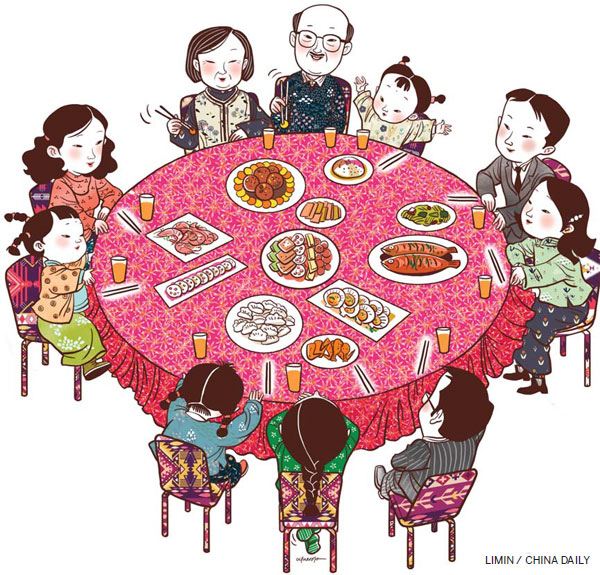Family etiquette lives on at the dinner table
Editor's note: To understand China you have to sit down to eat. Food is the adhesive that holds the Chinese social fabric together. In the face of increasing globalization, food is also one of the last strong visages of community and culture.
Every meal in a Chinese family is a manifestation of the ordered hierarchy within. The first to lift a pair of chopsticks is usually the head of the family, or an important guest. And although most Chinese meals are eaten at a round table, there is still a place of honor, usually the seat facing the entrance or the access to the dining room.
The next most important members of the family are seated to the left or right of the patriarch or matriarch in descending order. Often the most junior member may find himself face to face with the head across the wide expanse of the table.

The best and richest offerings are always placed near the seat of honor, although these days a revolving Lazy Susan tray may neutralize that strategy.
Once all the diners have gathered, the serious business of eating begins.
In the more traditional families, the most junior diner would start the ball rolling by inviting his elders to partake of the meal.
"Grandpa, please eat. Grandma, please eat. First uncle, please eat. Second aunt, please eat ... " Until even a cousin merely three months older has been greeted. Generally, this rather cumbersome custom has been mostly abandoned, sacrificed to the demands of instant gratification.
Once the older diners start helping themselves to the food the younger ones can relax. But there still are certain rules of etiquette that must be observed.
You are supposed to take food from the plate nearest you and you must never flip through the food with your chopsticks. It is considered both rude and unhygienic.
Diners around the Chinese table often pick up choice morsels and place it in each other's bowls. This is the ultimate expression of affection and of saying "I care".
In the normally recalcitrant family, where even parents find it hard to express love for their children verbally, these little gestures are important signals.
Thus, a favored child or honored guest may get a chicken drumstick, a succulent piece of fish belly or a tender piece of pork.
When the meal is completed, the pair of chopsticks is always neatly placed by the side of the bowl, and never on top of the bowl or, worse, stuck into the remains of the meal.
Some hosts may get seriously upset as a pair of chopsticks on top of the rice bowl is usually what is placed at the altar to dead ancestors.
Table manners are what makes the meal, although much has been lost in recent years, especially in the turbulent times of the 1960s and '70s. A lot of traditions have been preserved by Chinese families whose ancestors left the motherland during the first great diaspora in the early years of the 20th century.
Nevertheless, the basic rituals of eating at the Chinese table have remained largely intact but are now often practiced only during business lunches or meals with work unit leaders.
And that's pretty telling.
pauline@chinadaily.com.cn


















